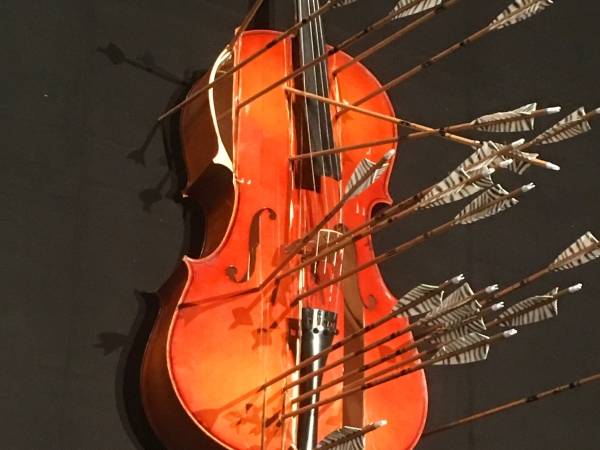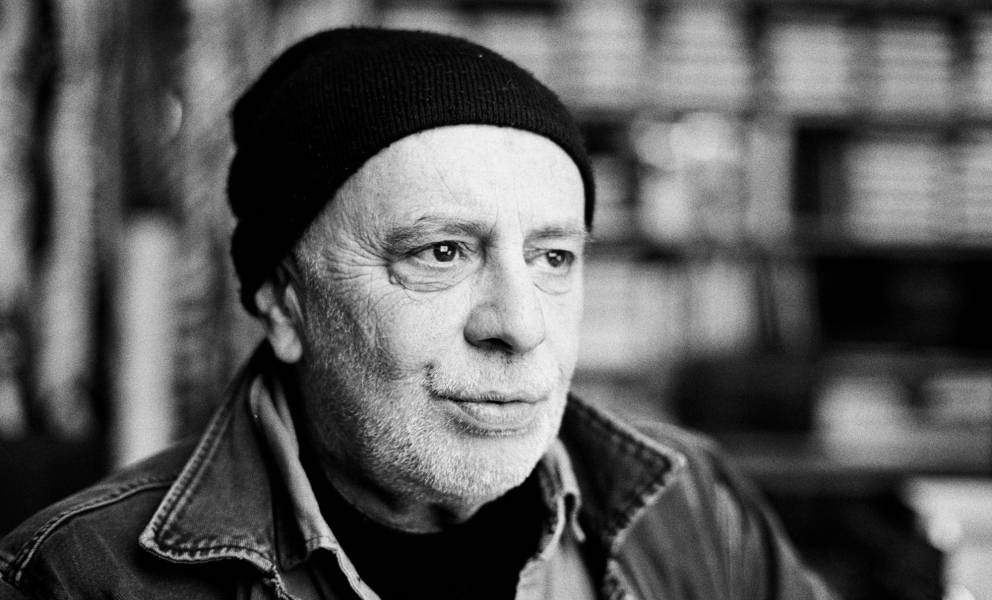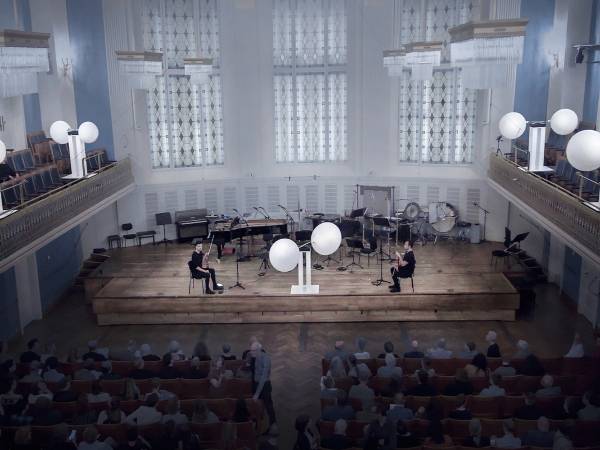10 Minuten
A ground moraine of erratic thoughts along with mannered and mannerist micro-sermons (in textual form) on text, music and theatre.
Words are the most uncertain symbols, devised by human beings for communication. (Kitasono Katue, A Note on Plastic Poetry, 1966)
The Example of the Kitchen Radio – musica vs. lingua
When you haven’t been able to understand language for a good while (because it is too soft and the surroundings are too loud), music can still be understood for a long time – even if only fragments protrude from the noise (the tiny, chirping radio against the overpowering organ-sounds of the dishwasher) like the spine of a sunken mountain.
*
when a text abandons its book, most of the time it becomes embarrassing, although that wouldn’t be the case had it remained in its book. and singing is of no help here.
wagner’s babbling and bubbling is/would be embarrassing as a book, but in music theatre it is the only text among them all that is not embarrassing (because of being understandable precisely through the babbling and bubbling).
every text (in the so-called ‘commonly accepted’ sense of the word) should be distrusted on principle to the highest degree – the same as with music (when the text consists of letters and the music of notes (or something similar)). everything that seems to make sense but in fact is only pretending to do so is downright intentionally malicious (?) and is nothing other than abuse of (most of the time) not mastered linguistic and musical syntax and semantics for the secretion of (mostly) maudlin, general platitudes, whisked together with private fairy tales.
edible but without nutritional value
if ‘text’ means a woven structure, an impenetrable clump that cannot be untangled, a texture even if perhaps not beautiful, a hairball that trickles into all sensory channels but that cannot be deciphered, decoded or merely denuded: then you can take pleasure and don’t have to be fearful.
unenjoyable but highly nutritional
and now, formulated much better by David Foster Wallace:
Art is in the final analysis communication, and a “personal impression” only becomes interesting in a filmic sense when that which has come to expression strikes a chord in the viewer. The difference between experiencing an art that succeeds as communication and an art that fails in that endeavour corresponds to the difference between having sex with a person and observing that person in the act of masturbation.1
Opera Vacui
I’m looking for a word, a designation for music theatre such as I imagine it. It should have its own term – not music + theatre. A word that says something and thereby leaves everything free and gets it going.
It should stand for a kinetic process that manifests itself into all senses of the perceiver, that can be explored, read by all the senses.
It should NOT be a matter here of binding a bouquet together out of several parallel processes (the interdisciplinary assertion) but of the fact that ONE process is accessible on all sensory levels, that it plays, lies ready because this is its ‘nature’ and nothing else is possible – which doesn’t exclude the fact that also a text can come to light along several tentacles or openings of this process; but it does not underlie things2 and furthermore it is not excluded that when you don’t watch or sniff, you hear or feel. He and she that will not hear may see.
Opera Vacui would be a provisional, makeshift term for this.
The Opera Vacui has no intentions and no meanings that are costumed with sounds and images3. It is devoid of stories and history, an empty sheet of paper before someone writes on it: “now I’m going to tell you …”4 – because it is precisely here that the Opera Vacui doesn’t cooperate any longer.5
With the Example of an Excavator – deus ex machina
EAn excavator digs a pit, perhaps on a summer evening. It dumps the diggings alongside the pit into a cone. The public stands, sits, wanders about – everyone is left undisturbed.
You (as a visitor) see and feel the cone of crushed rock or dirt that is slowly becoming larger; you perceive the pit gradually deepening; you hear the motor and smell the diesel, noise and stench; you see the exhaust rising; you observe the self-sorting of the rocks as they are piled up, the gravity and the sound in everything, the space, the light and the shadows that are altered by the course of the sun and by the continuous modification of the landscape by the excavator; you feel the heat of the machine, the chill from the opened-up ground, your own body in the space, heaviness or energy, sadness or joy – in whatever casing (or with whatever core) one is in attendance. Clothed in this brought-along mood, which perhaps changes, you observe the person operating the excavator involved in the digging and dumping, full of concentration and delight. Perhaps the person is listening to music on earphones or may be seen receiving a telephone call and speaking. Perhaps KOMATSU is written on the arm of the excavator – here there is even the text. Gradually darkness descends and the floodlights of the excavator illuminate the pit. Mazy comets of insects and foggy swaths of diesel.
Heretofore the subjective and surmised description of an Opera Vacui, which arises out of a not only apparently simple instruction:
Excavate a square pit with flat bottom as deep as possible and release the diggings alongside the pit at a point that is constantly the same, so that a bigger and bigger cone is gradually piled up. The piece is concluded when the bucket of the excavator can no longer reach the tip of the cone and the excavator is standing on the ground of the pit it has itself dug.
There is no need for an indication of what was done when or how, what the ‘expression’ is or the intention. Intention and working steps determine each other reciprocally, compellingly and simply. It is not a matter of opening the ears that you bring into a concert.
But what is this all about? (frequently asked questions)
- the saying about the hole that you dig for others?
- a meditation about matter and emptiness?
- about substance and form?
- the depiction of a mass grave?
- the excavation site for an opera house?
- deliberate field damage to flora and fauna?
- the noises of the excavator, the rocks?
- the emotional life of the excavator operator?
- traces?
- a geometrical exercise that leaves behind an empty cuboid and a full cone, with the cone being the mother of the cuboid and the cuboid the father of the cone?
- the expectation of an unhoped-for excavation?
- is it music theatre, composition, text, theatre?
Answer
- no!
Nothing is said or claimed. The meanings (and from this point also even the stories) arise only through the experiential backgrounds of the individual persons who are present, or who only read or hear about it.6.
Diverse – just as the rabbit can be a symbol of resurrection, a pest, a Sunday roast, a master of fertility or a cuddly companion, and even more. As long as it is ambivalent, the rabbit is interesting. If it is a resurrection rabbit or a roast rabbit, you know how things stand, but it has already hopped along on its way – there is nothing more to stare at!
The excavator operator (I imagine a man with pianist’s hands and hockey hair) retains his virtuosity, which it is a pleasure to observe. No one prescribes what angle the bucket must be, where its shadow is supposed to fall or even when or how much he should accelerate in order to generate a particular sound. The core of the whole affair has been planted, not the treetop; everyone has their dignity preserved, no text nails down anything. Music theatre that only seeks to tell one story is nothing more than propaganda, nothing more than the act of nailing down.7 Only music theatre that doesn’t want anything and thereby facilitates and liberates stories generates a free space – and that is everything that we should need, even if it is a strenuous habitat.
*
Two Uncomfortable Clichés – musica ex humptata
#1
“This text is musical!” (whereby literature is meant, commonly). What is thereby meant is in any case ‚musikantisch’ – something completely different and actually devastating for the text praised as ‘musical’, because it means the compliant rendition of the expectable in a cozy, harmonious, predictable rhythm. With vowel repetitions – such as one imagines with music and cradle songs.
#2
One of the dumbest and most perfidious expressions of all: “Music is a global language!” a standing text, as striking as a standing violinist and as unnecessary as the gilding on the statue of Johann Strauss in Vienna’s Stadtpark. As if there existed a medium that could simply transfer mankind and its languages and dialects back into a state before the Tower of Babel. This statement, however, is just what is needed for handlers of child prodigies in their paedophilic jackets made out of imitation crocodile leather. Along with espadrilles.
*
The Story of Air and Feather
whoever wants a text has to write (feathers and tars)
When Mr. J. S. Bach wrote his musical text, he used a feather. And ink. A goose – quite specifically, a quill feather plucked from its arm8, was the conveyor of the construction (of its abstraction in the form of notation) from the composer’s brain onto the paper where then, as soon as the ink had dried, it became a message for instrumentalists. There was inking! Sepia- brown squid juice. But then there reappears the goose (devoured by music molluscs): goose quills write a second time, now in the air. Inasmuch as they pluck/pick the strings in the harpsichord (which clumsily imitates the form of the later grand piano), they set free once again what was previously written. It flies away immediately, goose-free.
Certainly a unique moment in musical history in which writing utensil and musical instrument were identical in their central ‘constructional element’ (in the gears, where the translation occurs), whereas in the successor of both the harpsichord and the goose feather, there is a continuation of affinity in the piano mechanics and in the typewriter. If the harpsichord was a fluttering Icarus imprisoned in a box, now Thor works his hammer in the piano – but for a long time further according to a plan that continues to be written with a feather.
*
Further Acts for an Opera Vacui
The Wind out of the Books
While flipping through books, a tiny breeze arises. Text, perhaps also written notation (which justifies the existence of the book) gives rise to music (moving air). A quiet opera that can cause a candle flame to flicker.
Gunshots out of Books
Select a book, a hardcover. Trivial or high literature – in any case one, where gunshots can be expected. Read along quietly. In the instant when a shot is fired in the text, slam the book shut as loudly as possible. Then find the place again and continue reading – right up to the next gunshot.
Ritual
Energy drinkers carry around their cans slowly and thoughtfully like short but thick candles from a first communion – with little fingers spread apart and Pasolini-like nun’s gaze. “Introibo ad altare Dei!” (dog Latin attributed to James Joyce or the Viennese poseur Papst Locherl). 4 gopniks are an advent wreath with 3 stripes.
***
Originally published in: TEXT AS SOURCE AND MATERIAL IN CONTEMPORARY MUSIC THEATRE, edited by Christa Brüstle, Vienna - London - New York 2023 (Studien zur Wertungsforschung 65), ISBN 978-3-7024-7793-6
- 1
David Foster Wallace: Der Spaß an der Sache, S. 667
- 2
not least of all because text can’t do this.
- 3
the customary scenographic masquerade.
- 4
if an ego (the important EGO) wants to tell something about itself, it can of longer.
- 5
this doesn’t have anything to do with Zen but is an old, rural Upper Austrian attitude – see Bruckner.
- 6
the act of imagining of the performance is already sufficient.
- 7
a well-known exercise for more than 2,000 years.
- 8
the right one?
Georg Nussbaumer
Georg Nussbaumer, born 1964 in Linz, lives in Vienna. Nussbaumer is regarded as a virtuoso Gesamtkunstwerker whose works move between composition, installation art, performance and theatre. He works with highly specialised performers and musicians just as naturally as with archers, freedivers, a motorbike club or hundreds of singers from rural amateur choirs. His large-format works have been shown at venues including: Donaueschinger Musiktage | Wien Modern | Steirischer Herbst | Berliner Festspiele - Maerzmusik | Bregenzer Festspiele - Kunst aus der Zeit | soundscape Vilnius | Ring Festival Los Angeles | radialsystem Berlin | KunstFestSpiele Herrenhausen | Opera Dagen Rotterdam | Kunstfest Weimar | operadhoy Madrid | Philharmonie Luxembourg | Festival Klangbasel | O.K - Offenes Kulturhaus OÖ | Höhenrausch Linz | Beethovenfest Bonn | Gasteig München | and many more.
Article topics
Article translations are machine translated and proofread.
Artikel von Georg Nussbaumer
 Georg Nussbaumer
Georg Nussbaumer 



